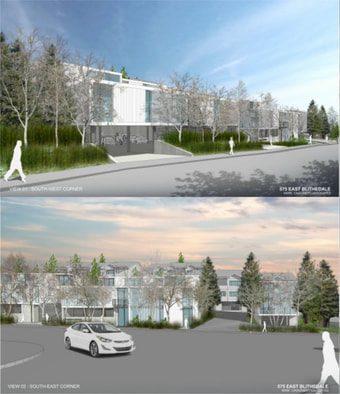 Renderings of Phil Richardson’s proposed project at 575 East Blithedale. Courtesy images.
Renderings of Phil Richardson’s proposed project at 575 East Blithedale. Courtesy images.
“Whites-only subdivisions, redlining, and other discriminatory practices have effectively discouraged and prevented many people of color from settling in Mill Valley,” the task force reported in its section of five specific recommendations on how to create more affordable, equitable housing opportunities in Mill Valley.
“As in communities across the nation, housing segregation in Mill Valley has operated to establish and deepen racial disparities in wealth, education and other basic rights and opportunities,” the report continued. “Mill Valley’s soaring housing prices operate—by means of the racial wealth gap—to reinforce the exclusion of Black people and other people of color. Workers in Mill Valley’s service sector, many of them people of color, are forced to commute great distances due to the lack of affordable housing.”
The report recommended increasing affordable housing in Mill Valley by pursuing regulatory options for pathways to ownership for low- and moderate-income people, as well as programs that seek to divide large, single-family homes into two homes, much like the House Mill Valley program the City recently created via Covia. The task force also highlighted the need to not just create more affordable housing, but also to redress historical inequities, particularly those that restricted by law the ability of indigenous and BIPOC to purchase homes in Mill Valley.
The DEI Task Force’s report comes on the heels of a comprehensive study by the Othering and Belonging Institute that found that six of the 10 most racially segregated municipalities in the Bay Area are in Marin County, with Mill Valley at #9. The study shows that in a wealthy county like Marin, where the average home price is just under $1.3 million, strict single-family zoning all but ensures that communities will remain wealthy and white, according to the San Francisco Chronicle. “Most of Marin County is zoned for single-family homes, and the communities with the highest percentage of single-family home zoning tend to be the whitest,” the Chronicle reported.
The study and the task force’s report has local developer Phil Richardson feeling relatively optimistic about his chances of bringing a multi-family housing project to his long-vacant property at 575 East Blithedale Avenue that has been through multiple iterations since he bought the property in 2004, from stiff opposition from neighbor groups that have packed public hearings to his hiring of land-use attorneys and engaging in sign wars.
The project, which Richardson says he expects to formally submit to the City of Mill Valley this month, drew the attention of CBS SF Bay Area, which focused on whether the heightened energy around affordable housing in Mill Valley could improve Richardson’s chance to garner approval for his Richardson Terrace project, which calls for 25 homes – six market-rate homes for seniors, six homes for lower-income residents, 13 market-rate homes and 2,000 square feet of office space.
The piece also focused on Omar Carrera, executive director of the Canal Alliance, which provides direct services in areas most needed by immigrants to overcome poverty. Carrera said Mill Valley and its neighbors throughout Marin have a lot of work to do to create more equitable housing opportunities.
“In Marin County, we have learned how to be racist without saying it that directly,” Carrera said. “All we have to do is use the environmental argument and the historical argument to maintain community segregation.”
